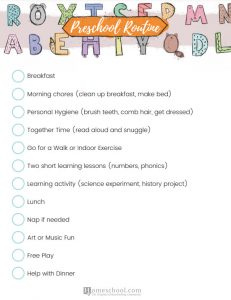Preschool is a wonderful age because these young children are just starting to learn school basics and are full of natural curiosity. They want to learn how to do things on their own, which is exciting but intimidating for parents.
After all, it’s easier just to take care of things ourselves, right? But, we step back anyway and let them try — because this is their time to learn.
It’s easy to get caught up in overthinking all the details of homeschooling a preschooler, especially if you are new to homeschooling. However, there’s good news to take the weight off your shoulders:
PLAY is the best way to teach a preschooler!
Your preschooler will learn endlessly through the wonders of play and games. In fact, we all learn best when we are having fun, and that is especially true for preschoolers!
Truly. Focus on play. Learning games, board games, online games, apps, pretend, toys, etc., are all educational tools for a preschooler.
The learning will come naturally, we promise.
To that extent, in this article, you’ll learn how to incorporate educational elements into your preschooler’s daily routine.
How Do I Know If My Preschooler Is Ready for School
Your child instinctively wants to know about anything and everything, occasionally perhaps a little more than you’d like! However, their natural inclination to explore is the perfect foundation for starting their homeschool journey.
First, it’s important to determine whether your child is ready for school. Here are a few signs of homeschool readiness:
- Know their ABCs.
- They recognize letter sounds.
- Understand the concept of sounding out words and stringing together letter sounds.
- They show an interest in reading.
- Pretend to read or write.
- They are engaged during storytime.
What Do I Teach My Preschooler
Once your “little” is ready to begin their preschool journey, you’ll want to make a list of learning ideas for their year. Consider these ideas when deciding how to preschool at home:
- Focus on play. Play is the most important activity for preschoolers! Indeed, play is their schoolwork.
- Begin involving them in daily activities. These little ones can learn so much from being involved in your daily tasks!
- Take time to explain why & how. By involving them, be sure to take time to explain why you do something, and how it is being done. They are soaking it all in!
- Create a routine. This will help begin to structure your preschooler’s days.
- Game school. Just like we said earlier, play, play, play! Game schooling is the perfect way to combine learning with their natural curiosity!
- Explore the outdoors. Walking, hiking, swimming, start nature journaling, catch tadpoles or bugs, collect leaves or acorns, or whatever you’d prefer!
- Provide toys that encourage imagination. Consider books, coloring, blocks, LEGOs, and so on.
- Focus on learning. It makes a difference when you are focused on what they can learn, versus what you can teach!
- Go on field trips. Visit the zoo, an aquarium, a petting zoo, a farm, etc.
- Let them be little. They will make messes. Finger painting, Play-Doh, drawing, glittery crafts, mud…it will be messy. And yet, super fun for them while creating precious memories — and they WILL be learning.
Life Skills and Learning Objectives for Preschool Homeschool
For preschool learning objectives, there are a few basics to cover. While you want to still focus on keeping it fun and enjoyable, ticking these objective areas will prepare your child for kindergarten. For a preschool student, objectives comprise both life skills and academic goals. Of course, the specifics depend on your child and your family’s lifestyle.
However, examples are always helpful. Here are a few academic and life-skill objectives to consider for your preschooler!
- Potty training
- Proper handwashing

Click to Print A Preschool Routine Checklist - How to write their name
- Verbally recall their parents’ names
- Knows ABCs, verbally and written both lowercase and uppercase
- Tying shoes
- Listen without interruption
- Identifies and writes numbers 1-10
- Wait and take turns
- Follow directions/instructions
- Knows the days of the week/months of the year/seasons
- Can trace shapes and letters
- Recognizes different types of weather (i.e. sunny, cloudy, rainy)
- Knows how to hold a pencil
- Understands basic shapes and primary colors
- Demonstrates an understanding of word tenses: “yesterday,” “today,” “tomorrow”; “go,” “going,” “gone,” etc.
A Sample Of A Homeschool Preschool Schedule
You’ve probably already been told to “just let them play” a thousand and one times on social media, and it may even feel like unhelpful advice at this point. We’ve impressed it repeatedly in this post as well, so I’m taking a moment to acknowledge that.
But, if you’re reading this article, you already know play is super important for preschoolers.
The fact is, you still need help teaching the basics like ABCs, numbers, shapes, etc. You know all about play, but how to make sure your preschooler learns the essentials?
We get it. We’ve been there.
One of the most helpful resources I’ve found is an example of a preschool day.
Finally, I had answers and ideas about how to actually help my preschooler through their day!
However, as with all examples, take it with a grain of salt. Don’t fall into the trap of comparison. Comparing your child’s learning progress to other children is stress-inducing and lowers the quality of your experience.
To that end, preschool activities will look different each day, and that’s a good thing! A rigorous homeschool schedule is more important for higher grades than the preschool age.
We’d recommend you adopt more of a routine rather than a schedule for your child. Children thrive on routines. Honestly, we’re all happier when we know what to expect!
Here is an example of a preschool routine:
- Breakfast
- Morning chores (clean up breakfast, make the bed)
- Personal hygiene (brush teeth, comb hair, get dressed)
- Together Time (read aloud and cuddle)
- Go for a Walk or Indoor Exercise
- Two short learning lessons (numbers, phonics)
- Learning activity (science experiment, history project)
- Lunch
- Nap if needed
- Art or Music Fun
- Free Play
- Help with Dinner
How to Teach In a Homeschool Preschool
Homeschooling preschool is pretty much the best because you don’t need a rigid schedule, lesson plans, or grades.
As far as homeschool requirements go, they are usually fairly lenient for preschool, but you should always check with your state laws anyway. Many states don’t require notice at the preschool age.
Truth be told, preschool education is an important part of a child’s educational development. Preschool-aged children need stimuli, encouragement, and structure. At this age, their minds are natural sponges — they absorb everything! A study has shown there is an actual, measurable difference in success between adults who’d had a preschool program as children versus those who did not.
In a nutshell, foundational preschool education is a common denominator among successful adults!
Of course, you’re invested in your child’s education. Even though preschool may not call for a detailed plan, it’s still a good idea to get organized. You can’t reach a goal without a plan, right?
Here are a few steps for getting started.
- Step 1: Choose a Homeschool Planner. We love our Sanity Saver Planner because it’s more than just a planner.
- For example, it has a chore chart and a meal plan.
- It’s printable, which means you can also duplicate pages to add as many sheets as you need.
- Step 2: Examine Your Options. Do you want to freestyle your preschool or use a curriculum? Homeschool curricula still focus on fun and games for preschoolers!
- A curriculum could help eliminate worry over learning gaps and take the load off your shoulders.
- Step 3: Select Your Program. Whether you create a preschool plan purely from books, printables, and online learning resources or you go with a curriculum, now is your chance to make the decision.
- Step 4: Create a Plan. Write down your goals and objectives for the year. What would you like your preschooler to know by the end of the year?
- Tip: it can help to look ahead in Kindergarten lesson plans to know how to start a preschool.
- Outline a very basic plan based on those objectives. You can divide your homeschool year into semesters and months if that’s easier.
- Don’t worry about the details too much, and certainly don’t stress over pinning down a daily preschool schedule. Life with a preschooler is fluid!
Helpful Resources for Teaching a Preschool Homeschooler

In this list, you’ll find several helpful articles, tips, tricks, activities, and even a science experiment or two.
On another note, it helps to log your daily activities and worksheets for fulfilling homeschool requirements. You’ll never know when a portfolio will come in handy, especially if you live in a state with strict homeschooling laws. It’s better to have more records on hand than less!
Either way, these resources are here to give you a starting point for teaching your preschooler.
Fun Learning Materials:
- Preschool printables.
- A-Z Animal Alphabet Flashcards
- Alphabet Coloring Pages
- How to know if your preschooler is ready to read.
- Preschool ocean-themed activities
- Color Practice Worksheets
- Practice drawing with symmetry!
- Fine motor skills activities for preschoolers


